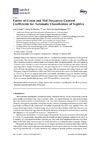Identificador persistente para citar o vincular este elemento:
https://accedacris.ulpgc.es/jspui/handle/10553/37100
| Título: | Fusion of linear and mel frequency cepstral coefficients for automatic classification of reptiles | Autores/as: | Noda, Juan J. Travieso-González, Carlos M. Sánchez-Rodríguez, David |
Clasificación UNESCO: | 240601 Bioacústica 330702 Electroacústica 240114 Taxonomía animal |
Palabras clave: | Biological acoustic analysis Bioacoustic taxonomy identification Reptile vocalization Frequency cepstral coefficients SVM, et al. |
Fecha de publicación: | 2017 | Publicación seriada: | Applied Sciences (Basel) | Resumen: | Bioacoustic research of reptile calls and vocalizations has been limited due to the general consideration that they are voiceless. However, several species of geckos, turtles, and crocodiles are able to produce simple and even complex vocalizations which are species-specific. This work presents a novel approach for the automatic taxonomic identification of reptiles through their bioacoustics by applying pattern recognition techniques. The sound signals are automatically segmented, extracting each call from the background noise. Then, their calls are parametrized using Linear and Mel Frequency Cepstral Coefficients (LFCC and MFCC) to serve as features in the classification stage. In this study, 27 reptile species have been successfully identified using two machine learning algorithms: K-Nearest Neighbors (kNN) and Support Vector Machine (SVM). Experimental results show an average classification accuracy of 97.78% and 98.51%, respectively. | URI: | https://accedacris.ulpgc.es/handle/10553/37100 | ISSN: | 2076-3417 | DOI: | 10.3390/app7020178 | Fuente: | Applied Sciences (Basel) [ISSN 2076-3417], v. 7 (2), article number 178 |
| Colección: | Artículos |
Citas SCOPUSTM
5
actualizado el 08-jun-2025
Citas de WEB OF SCIENCETM
Citations
4
actualizado el 08-jun-2025
Visitas
108
actualizado el 20-jul-2024
Descargas
141
actualizado el 20-jul-2024
Google ScholarTM
Verifica
Altmetric
Comparte
Exporta metadatos
Los elementos en ULPGC accedaCRIS están protegidos por derechos de autor con todos los derechos reservados, a menos que se indique lo contrario.
